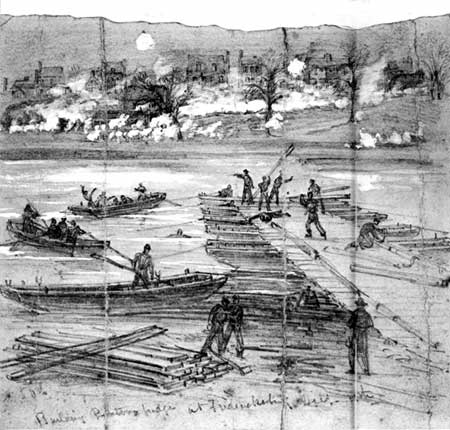|
FREDERICKSBURG and SPOTSYLVANIA COUNTY BATTLEFIELDS MEMORIAL National Military Park |
 |

Working under a brisk and accurate rifle fire,
Federal engineers begin laying a pontoon bridge across the Rappahannock
early on the morning of December 11.
Courtesy, Library of
Congress.
ACROSS THE RAPPAHANNOCK
Wednesday, December 10, dawned gray and blustery. Snow blew across the tents and guns and covered the fields. The cold wind cut through the men, as couriers galloped from Burnside's headquarters with the orders that finally set the Army of the Potomac in motion.
Franklin's Left Grand Division would cross the river below Fredericksburg and advance on Jackson's position; Sumner's Right Grand Division was to cross opposite the city and attack Longstreet on Marye's Heights; Hooker's Center Grand Division was held in reserve, ready to support either wing if the occasion warranted.
Early the next morning under cover of a heavy fog, Federal soldiers began laying the pontoon bridges, six in all, varying in length from 400 to 440 feet. Below the city the work proceeded as scheduled, but opposite Fredericksburg it was a different story. As the first rays of sun pierced the mist, Confederate sharpshooters, concealed in the houses and streets, opened a deadly fire. The bridge building stopped.
Burnside ordered a bombardment. The massed Federal artillery on Stafford Heights opened with a frightful roar. A storm of shot and shell tore through the streets, alleys, and houses. spreading death and destruction. Thick clouds of smoke swirled high in the air as buildings caught fire. Walls and chimneys crashed to the ground. Yet when the bombardment lifted and the smoke drifted away, the sharpshooters were still there.
In desperation the Federal officers called for volunteers who were ferried across the river in a daring bridgehead operation. After bitter house-to-house fighting, the outnumbered Confederates withdrew to the heavily fortified heights behind the town, enabling the engineers to complete the bridges.
The next day Federal troops poured over the river. Franklin put Reynolds' I Corps on his left opposite Jackson's right at Hamilton's Crossing where the Mine Road crossed the Richmond Fredericksburg, and Potomac Railroad. Smith's VI Corps formed on Reynolds' right, opposite Jackson's left at Lansdowne Valley. Sumner had Couch's II Corps in Fredericksburg, and Willcox's IX Corps just south of the city connecting with Smith's right near Deep Run. By nightfall everything seemed set. Corps and division commanders waited anxiously for their attack orders. Behind them was the river; in front were the heights. bristling with Confederate cannon and bayonets.

|
|
Last Modified: Mon, Dec 2 2002 10:00:00 am PDT |


